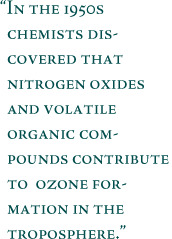

| |||
Chemistry of Ozone
Formation
In the language of a simplified chemical formula,
In the troposphere near the Earth’s surface, ozone forms
through the splitting of molecules by sunlight as it does in the
stratosphere. However in the troposphere, nitrogen dioxide, not
molecular oxygen, provides the primary source of the oxygen atoms
required for ozone formation. Sunlight splits nitrogen dioxide into
nitric oxide and an oxygen atom.
Nitrogen oxides (NOx) Nitric oxide and nitrogen dioxide are together known as NOx and often pronounced “nox.” Sources of NOx include lightning, chemical processes in soils, forest fires, and the intentional burning of vegetation to make way for new crops (biomass burning). NOx also come from smokestack and tailpipe emissions as by-products of the combustion of fossil fuels (coal, oil, and natural gas) at high temperatures. Coal-fired power plants are the primary sources of NOx in the United States. Automobiles, diesel trucks and buses, and non-road engines (farming and construction equipment, boats, and trains) also produce NOx.
Volatile organic compounds (VOCs) such as hydrocarbons. “Volatile” refers to an extreme readiness to vaporize. Some plants and bacterial processes in soils emit VOCs. (The smell of a pine forest comes from a hydrocarbon called alpha-pinene.) VOCs also come from gasoline combustion and from the evaporation of liquid fuels, solvents and organic chemicals, such as those in some paints, cleaners, barbecue starter, and nail polish remover.
Ozone formation in the troposphere requires both NOx and VOCs. In a
highly simplified version of tropospheric ozone-forming reactions,
The efficiency of ozone formation rises and then falls as the ratio of nitrogen oxides (NOx) to volatile organic compounds (VOCs) increases in an idealized plot. Higher NOx emissions result in less efficient ozone production. The modeler who made this plot intentionally left off all units of measurement, because the ratio itself is more important than the specific concentrations of the compounds. Authorities who want to control ozone production must take the ratio into account. (Graph courtesy Jim Meagher, NOAA Aeronomy Laboratory)
Ozone formation with the hydrocarbon methane provides a useful example of the general pattern that most such reactions follow. The methane example is somewhat simpler and easier to follow than the others, described in steps. Most ozone formations in the troposphere involve non-methane hydrocarbons. The chemistry of ozone formation from non-methane hydrocarbons follows the general pattern described above but is much more complex. NOx and VOCs together include about 120 different chemical compounds, and hundreds of chemical reactions can take place. Some of the participating chemicals may be intercepted part of the way through the process by reactions with other chemicals in the atmosphere, and may form intermediate compounds that act as temporary reservoirs for varying amounts of time.
An additional challenge arising for anyone tracking tropospheric ozone-forming reactions is that they entail interactions between different phases of matter (gas, liquid, and particles known as aerosols), and can occur on various kinds of aerosol surfaces in the atmosphere. Changing environmental conditions such as air temperature and humidity also affect ozone chemistry. Furthermore, many of the chemicals involved have very short lifetimes before they react with other chemicals to form new compounds. Scientists face myriad challenges in their pursuit of understanding tropospheric ozone chemistry. References Fishman, Jack. 1990. Global Alert: The Ozone Pollution Crisis. (New York and London: Plenum Press) Fishman, Jack, et al., NASA Langley Research Center, Hampton, VA. 1999. Surface Ozone Measurements: Exciting Science for All Seasons All the Time. Madronich, Sacha. 1993. Tropospheric photochemistry and its response to UV changes. In The Role of the Stratosphere in Global Change. Vol. 18. NATO-ASI Series, Editor M-L. Chanin. (Amsterdam: Springer-Verlag) Pp. 437-61 Turco, Richard P. 1996. Earth Under Siege. (New York: Oxford University Press) back: Ozone, Space, and Time
|

| ||